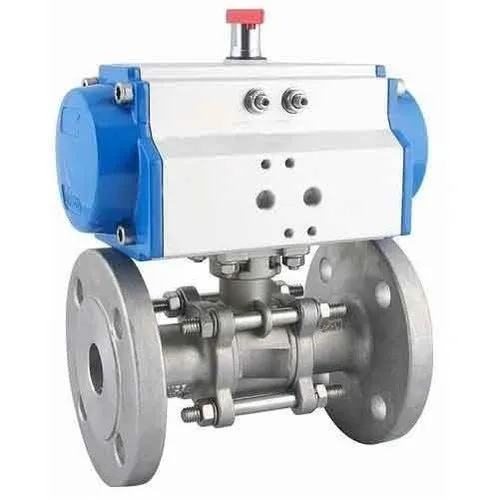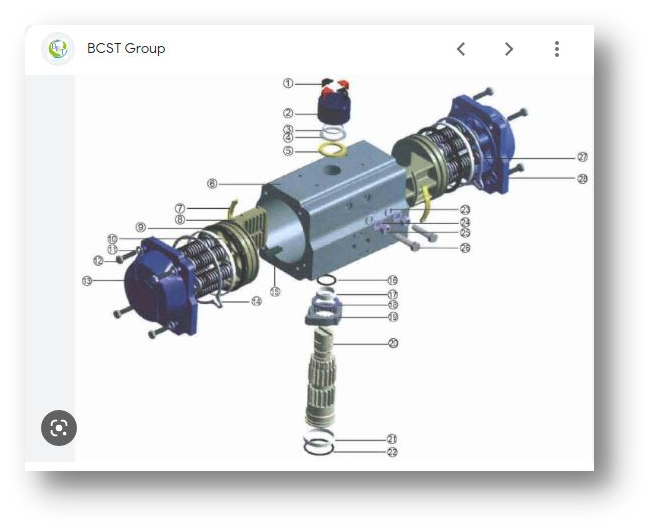
Generally, a valve alone cannot be used to control a process. Instead, an operator must place them, and a unique device, such as an actuator, must operate the valves remotely and automatically. Actuators are devices used to make something work or move. They come in three types, determined by the energy source: electric, hydraulic, and pneumatic. In this article, we will discuss pneumatic actuators – how they work, and their applications in the industrial sector.
What is a Pneumatic Actuator?
The pneumatic actuator transforms power from compressed air into motion. Various types of pneumatic actuators are available, with some converting compressed air energy into linear motion and others converting to rotary motion. Multiple names in the industry, such as air cylinders, air actuators, and pneumatic cylinders, commonly refer to these actuators. With their wide range of applications, pneumatic actuators have become an essential component of many automated processes.
How Does a Pneumatic Actuator Work?
A Pneumatic actuator is a mechanical device that uses compressed gas, such as air, to create pressurized energy that can be directed in either a circular motion or a straight line. This pressurized energy is then used to create a controlled and repeatable kinetic movement of a device such as a gear or a piston. The actuator is exceptionally reliable and is used in various industries today, providing the capability to convert compressed gas into a robust, controllable, and repeatable motion.
Construction & Working
The pneumatic actuator is a powerful mechanism that combines components such as a spring, compressor, reservoir, diaphragm, and valve. The accompanying diagram illustrates the construction of this system. In this mechanism, the energy of the fluid is converted into mechanical motion when the air is compressed by the compressor and stored in the reservoir. This stored air is then used to power the actuator, allowing it to move and perform its intended task.

The pneumatic actuator is a powerful mechanism that combines components such as a spring, compressor, reservoir, diaphragm, and valve. The accompanying diagram illustrates the construction of this system. In this mechanism, the energy of the fluid is converted into mechanical motion when the air is compressed by the compressor and stored in the reservoir. This stored air is then used to power the actuator, allowing it to move and perform its intended task.
This flow control valve helps to regulate the direction and speed of airflow from one area to another. The spring unit in the actuator ensures that the air is drawn from the atmosphere and filtered by a filter before it is given to the compressor. Once the control valve is open, the spring action pulls the diaphragm up. The compressor then compresses the air and increases the pressure level. This creates a strong air current that flows through the valve, allowing you to control the direction and speed of the airflow.
When the air pressure increases, the air temperature also rises. To keep the temperature within a comfortable range, air coolers are used. This pressurized air is then stored in a storage reservoir, allowing the pressure to be maintained. Additionally, the pressurized air within the system applies energy to the diaphragm of a pneumatic actuator. When the pressure of the air exceeds the force of the spring, it pushes the diaphragm to its highest point, causing it to move downwards and close the control valve.
When the air supply pressure is increased, the diaphragm moves continuously downward, eventually closing the control valve entirely. Conversely, when the air supply pressure is decreased, the force exerted by the spring overpowers the force of the supplied air, causing the diaphragm to move up and open the control valve.
The control valve’s position is determined primarily by the pressure of the air. As a result, the opening and closing of the valve are directly linked to the movement of its diaphragm in response to changes in the air pressure. Furthermore, the control valve will be automatically adjusted according to the pressure of the air, allowing for precise and repeatable control of the system.
Actuators are the critical element in controlling the action that needs to take place. They receive the control signal from the controller, which then changes the air pressure, resulting in a change in the position of the control valve. This actuator then executes the control signal, driving the process forward. In this way, actuators provide the control signal necessary for the preferred action.
Advantages
- Pneumatic actuators offer a range of advantages for linear motion control-based applications.
- They deliver high force and fast movement speeds and are also highly reliable and durable, making them ideal for applications where hygiene is essential.
- Additionally, they are cost-effective and easy to maintain and install.
- Wide temperature range (0 – 200 °C) and fireproof and explosion-proof capabilities make them an excellent choice for many applications.
- Pneumatic actuators are lightweight, making them easy to transport and install.
Disadvantages
The pneumatic actuator has some notable disadvantages that should be considered when choosing the right type of actuator for your application.
- Firstly, the output power of the pneumatic actuator is smaller than that of the hydraulic actuator, making it less suitable for applications that require high power output.
- Additionally, the internal parts of the pneumatic actuator are not lubricated by a fluid like oil, resulting in a lower output accuracy in low-velocity operations.
- Furthermore, these actuators are only suitable for specific applications, and their performance may suffer when used at lower speeds. Compressed air must also be prepared correctly, and any lubrication or oil can reduce maintenance.
Applications
Pneumatic actuators provide a versatile and reliable solution for various applications, ranging from industrial areas to aviation, railway applications, and combustible automobile engines.
These actuators are often used in pistons and ignition chambers of gasoline-powered vehicles, utilizing air ignition and gasoline to generate pressurized energy that moves the piston and converts the energy into the car’s crankshaft. They can also be powered by pressurized gas without ignition, providing a more efficient, cost-effective, and consistent mechanical force.
Pneumatic actuators are also essential for packaging and production machinery, air compressors, mail tubes, and transportation devices such as aircraft and railway applications. Its versatility and reliability make it ideal for various industries, providing a cost-effective, efficient, and safe solution.






